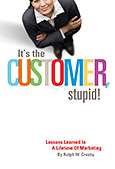How To Apply Dynamic Persuasion
In blogging recently about Jarol Manheim’s explanation of thematic consistency as the key to remembrance, I decided to go back to the source, his book The Politics Within, to revisit what else he said about sending messages successfully.
Though published in 1985, the second edition contains some very good marketing advice regarding the dynamics of persuasion.
Besides touting that thematic consistency creates a common link calling to mind earlier related messages, he suggested other factors that can enhance your messages:
- If the vehicle itself is attractive, he posited, the message it conveys may penetrate the brain’s screening process even when the product is no longer mentioned. For example, the use of a catchy tune or celebrity endorsement may bring to mind the advertised product or organization whenever the tune is heard or the celebrity is seen. Cases in point: United Airlines’ use of “Rhapsody in Blue” as a theme song and Michael Jordan’s Haines commercials.
- Controlling the timing of messages can create greater impact. That is, persuasive messages “have their greatest impact immediately after they have been issued, and that impact decays as time passes.”
- The use of saturation, or multiple exposures, will get some of your messages through a target’s mental screening process “simply because the sheer volume of messages beamed at an individual is too great for screening to be totally effective.”
These few examples do not do justice to Professor Manheim’s treatise on political attitudes and behavior, but they are instructive. While written before the proliferation of the Internet, his book contains an important explanation of how to get your messages through to your audience. And the ubiquity of web and social marketing make overcoming an individual’s screening barriers more important than ever.
The key takeaway from these few examples: Make your messages as memorable as possible so they will have “shelf life,” i.e., may be brought to mind even when what you are promoting isn’t mentioned; send the messages frequently; with the largest number early in your campaign; and make sure they are thematically consistent in both content and format.
At Crosby Marketing, this is part of our integrated marketing communications approach, in which all messages and mediums work together as a unified force. And believe me, it becomes a force to be reckoned with.
###

 Businesses often are started by entrepreneurs with an idea, a product or service, or an expertise. Many of them fail, not because the idea or product isn’t good, but because their attention is overwhelmingly directed internally – e.g., what goes into the product – when they should focus externally, always reminding themselves:
Businesses often are started by entrepreneurs with an idea, a product or service, or an expertise. Many of them fail, not because the idea or product isn’t good, but because their attention is overwhelmingly directed internally – e.g., what goes into the product – when they should focus externally, always reminding themselves:
